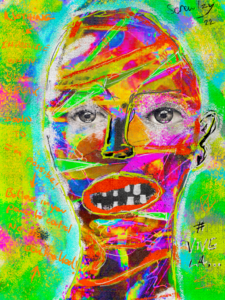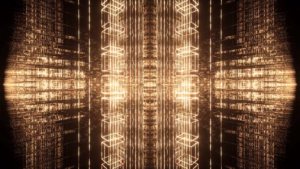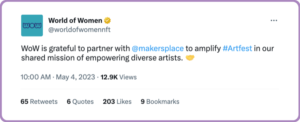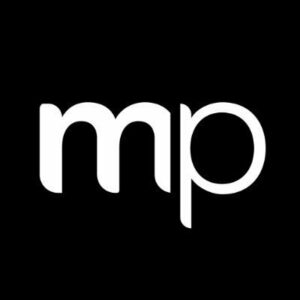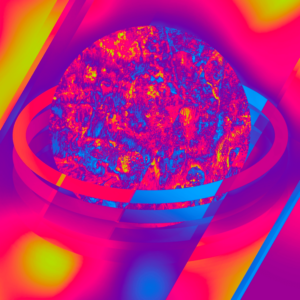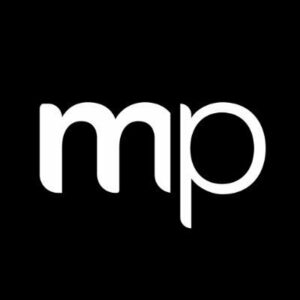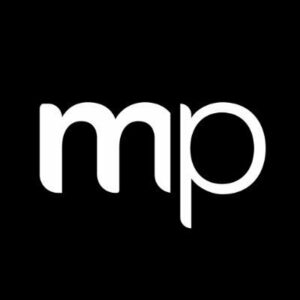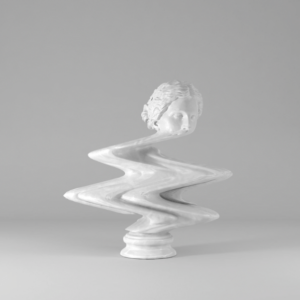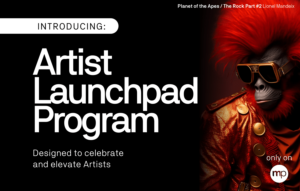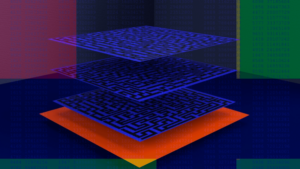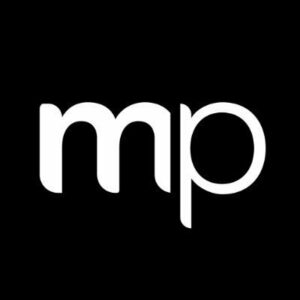A series of brief conversations with prominent AI artists to get a behind-the-scenes view of the different ways that AI fits into the creative process
Visit Studio Brasch’s MakersPlace profile
Brady Walker: Can you introduce yourself to our readers?
Studio Brasch: My name is Anders, also known as Studio Brasch. I’m a Danish artist currently working and living in Stockholm, Sweden. I have created art in many different mediums since I was a young boy, starting out with graffiti, then progressing to graphic design and typography, digital illustration/collage/painting, photography, sculpture, and even sound design. I used to combine all of this under an umbrella I called image-making.
Today, I’m combining all these experiences and influences using 3D and AI as these mediums allow me to express my imagination without too many technical limitations. I hold an MA in Visual Communication from UAL and have 15 years of experience working in the advertising and design industry as an Art Director, creating personal art on the side, which I sometimes have had the opportunity to inject into my commercial work.
However, this all changed 7 years ago when I discovered 3D and started creating virtual worlds, sculptures, and set designs, which people today refer to as ‘dreamscapes’. This was during a period when most people only associated 3D with industrial design and VFX. We were only a handful of artists — among them Six N Five, Andreas Reisinger, and Alexis Christodoulou — creating ‘dreamscapes’ at the time.
After posting my work online, I received a lot of press coverage, and I went to San Francisco for a week by personal invitation from Airbnb’s co-founder Joe Gebbia to give a talk about my work at their headquarters. After all this, brands started reaching out, and that has been my primary occupation since then. There are strong similarities between the work I create personally (NFTs) and the work I create for brands and agencies, which is why I have the same name in both worlds. In other words, my clients come to me for my personal work. That combined with being able to have my personal art collected is a dream come true for me.
My work stems from a deep fascination with the natural world, and how it relates to technology, and the times we live in. I’m inspired by science and natural phenomena, but I look at these things from a poetic rather than scientific point of view. I’m interested in the gray zones and the intangible that exist between nature and technology, and I try to give this form.

BW: What has AI allowed you to create that you never would’ve otherwise?
SB: For the last 7 years, I have worked relentlessly on my 3D modeling, digital sculpting, and texturing skills, a pursuit that is both time-consuming and exhausting (even if I do enjoy these activities). Working with AI removes a lot of this resistance. The timeframe from idea to the final product is significantly reduced, even if I do heavy retouching and combine different AI outputs.
Before, I was unable to create as much work as I can now, and concerns about complexity and intricacy are not a concern anymore. For my commercial art, however, I’m still relying on 3D as clients have yet to fully embrace AI and there are still many aspects of AI that make it unsuitable in the context of a commercial project.
BW: Can you describe your process from pre-idea to finished piece?
SB: The use of AI, for me personally, changes nothing about my creative process; only the production process is different. Things like endless notes in my notebook, thumbnail sketches, researching various topics, and thinking about ideas, all that is the same whether it’s 3D or AI.
I don’t have a defined step-by-step creative process (it depends on the project, though). Instead, I more often than not simply go where my heart leads me. I get most of my ideas when I’m running, actually, and not when I’m sitting at my desk. My desk is for execution, and my runs are for generating ideas and for imagination.
There’s something magical about the almost trance-like state of running in nature that helps me see things more clearly. For some reason, that environment allows me to really get to the core of the endless stream of thoughts and ideas I have. The creatives who run regularly will probably know what I mean.

BW: Do you have any practical tips for going from a total AI art beginner to a true AI artist? (Take the term “true AI artist” however you like)
SB: I think the ‘AI wave’ has created a slight misunderstanding in the wider art community. Yes, it’s easy to generate something common like an apple. But what will make that apple yours — that’s a whole other story.
In other words, AI is just a tool, the same way a camera, pencil, paintbrush, 3D program, Photoshop, or code library are just tools. To become a ‘real’ AI artist, you need to learn art fundamentals such as color theory and composition. Or, you can go the other way around, and unlearn everything about art fundamentals and propose an entirely new way of creating and seeing art.
To become a ‘real’ AI artist, you need to create something unique. Otherwise, how is your work different from that of any other person who also has access to AI?
BW: Can you give our readers a few prompt snippets or style prompts to experiment with?
SB: I don’t know what the reader might be into but one way to move forward would be to explore how an AI might see the things or subjects that you are interested in. You will quickly notice that some ideas are easy to generate while others are almost impossible. Don’t give up too quickly if you don’t get what you want, though; it simply means that you have highly original ideas that an AI has no references for — yet. That can be your advantage.
In fact, that is one of the motivations for my ongoing ‘Aikebana’ project. Here, again referring to the gray zone I previously mentioned, I’m interested in uncovering ‘natural’ digital artifacts from the latent space that have never been found before. So, my process is exactly that, I create absurd, senseless prompts, and I iterate on the same prompt over and over. So far, I have generated over 37,000 images and only released 196 Aikebanas. To me, that feels like uncovering something from the deepest end of the latent space, and I think my results reflect that.

Visit Studio Brasch’s MakersPlace profile
For updates on all of our editorial features, subscribe to our newsletter below.
- SEO Powered Content & PR Distribution. Get Amplified Today.
- PlatoAiStream. Web3 Data Intelligence. Knowledge Amplified. Access Here.
- Minting the Future w Adryenn Ashley. Access Here.
- Buy and Sell Shares in PRE-IPO Companies with PREIPO®. Access Here.
- Source: https://rare.makersplace.com/2023/06/05/ai-artist-qa-with-studio-brasch/?utm_source=rss&utm_medium=rss&utm_campaign=ai-artist-qa-with-studio-brasch
- :has
- :is
- :not
- :where
- $UP
- 000
- 1
- 15 years
- 15%
- 3d
- 3D modeling
- 7
- 9
- a
- Able
- About
- access
- activities
- actually
- ADvantage
- Advertising
- After
- again
- agencies
- ago
- AI
- ai art
- All
- allow
- allows
- also
- among
- an
- and
- any
- anymore
- Apple
- ARE
- around
- Art
- artist
- Artists
- AS
- aspects
- associated
- At
- BE
- become
- been
- before
- Beginner
- behind the scenes
- being
- below
- between
- blockchain
- both
- brands
- but
- by
- called
- camera
- CAN
- changed
- Changes
- clearly
- clients
- Co-founder
- code
- color
- combine
- combined
- combining
- come
- commercial
- Common
- Communication
- community
- complexity
- Concern
- Concerns
- context
- conversations
- Core
- coverage
- create
- created
- Creating
- Creative
- creatives
- Currently
- deep
- deepest
- defined
- depends
- describe
- Design
- designs
- desk
- different
- digital
- Director
- discovered
- do
- Dont
- dream
- during
- easy
- Editorial
- embrace
- end
- Endless
- enjoy
- entirely
- Environment
- Even
- everything
- exactly
- execution
- exist
- experience
- Experiences
- experiment
- explore
- express
- fact
- far
- Features
- few
- final
- For
- form
- Forward
- found
- Francisco
- from
- fully
- Fundamentals
- generate
- generated
- generating
- get
- Give
- Go
- going
- gray
- had
- handful
- Have
- Headquarters
- Heart
- heavy
- helps
- here
- highly
- hold
- How
- However
- HTTPS
- i
- idea
- ideas
- if
- images
- imagination
- impossible
- in
- In other
- industrial
- industry
- inject
- inspired
- instead
- interested
- into
- introduce
- invitation
- IT
- just
- Know
- known
- Last
- Leads
- LEARN
- Library
- like
- limitations
- live
- living
- Look
- Lot
- magazine
- mailchimp
- make
- many
- max-width
- mean
- means
- mentioned
- might
- misunderstanding
- modeling
- more
- most
- motivations
- move
- move forward
- much
- my
- name
- Natural
- Nature
- Need
- never
- New
- Newsletter
- NFTs
- no
- notebook
- Notes
- nothing
- Notice..
- now
- occupation
- of
- often
- on
- ONE
- ongoing
- online
- only
- Opportunity
- or
- original
- Other
- Others
- otherwise
- our
- out
- over
- People
- period
- person
- personal
- Personally
- photography
- photoshop
- piece
- plato
- Plato AiStream
- Plato Data Intelligence
- PlatoAiCast
- PlatoData
- plugin
- Point
- Point of View
- Practical
- press
- press coverage
- previously
- primary
- probably
- process
- Product
- Production
- Program
- progressing
- project
- prominent
- propose
- pursuit
- quickly
- rather
- reaching
- Reader
- readers
- really
- reason
- received
- Reduced
- references
- reflect
- regularly
- released
- relying
- Resistance
- Results
- retouching
- Run
- running
- same
- San
- San Francisco
- Science
- see
- seeing
- Series
- set
- side
- significantly
- similarities
- simply
- since
- Sitting
- SIX
- skills
- So
- so Far
- some
- something
- Sound
- Space
- started
- Starting
- State
- stems
- Still
- Story
- stream
- strong
- studio
- style
- subscribe
- such
- Sweden
- Take
- Talk
- Technical
- Technology
- term
- than
- that
- The
- their
- Them
- then
- theory
- There.
- These
- things
- think
- Thinking
- this
- though?
- thumbnail
- time
- time-consuming
- timeframe
- times
- tips
- to
- today
- too
- tool
- tools
- Topics
- Total
- true
- try
- typography
- umbrella
- unable
- under
- unique
- Updates
- use
- used
- using
- various
- View
- Virtual
- virtual worlds
- want
- was
- Way..
- ways
- we
- Web3
- week
- went
- were
- What
- when
- whether
- which
- while
- WHO
- whole
- why
- wider
- will
- with
- without
- WordPress
- WordPress plugin
- words
- Work
- worked
- working
- world
- world’s
- would
- years
- yes
- yet
- you
- young
- Your
- yourself
- zones

